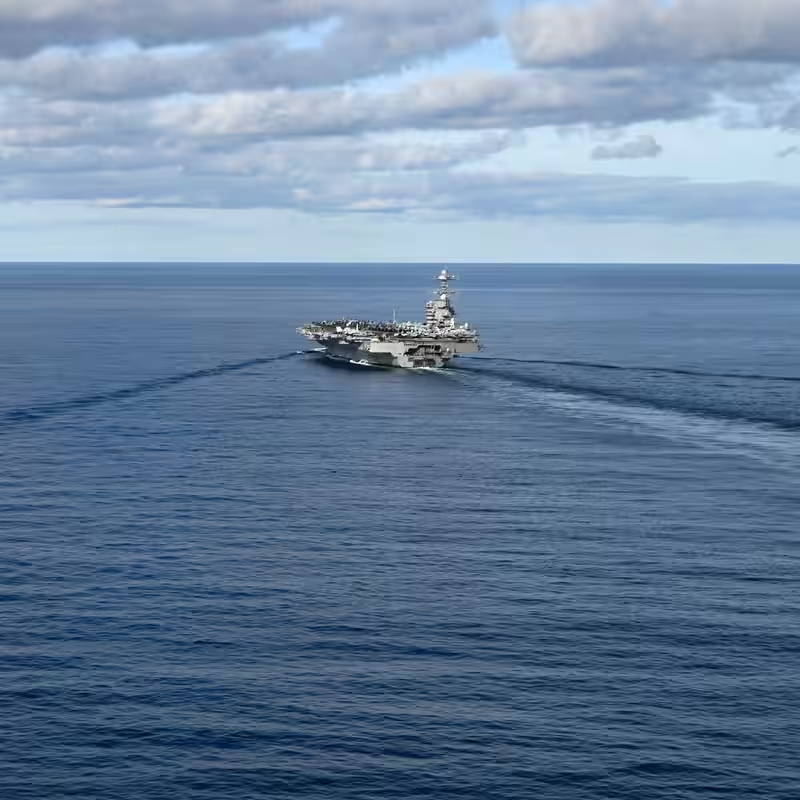Table of Contents
- What Is the USS Gerald R. Ford?
- Why Is It Heading to Latin America?
- Meet the Ford Carrier Strike Group
- Air Wing: A Floating Air Force
- Recent Deployments and Strategic Shift
- What This Means for U.S. Southern Command
- Sources
What Is the USS Gerald R. Ford?
The USS Gerald R. Ford (CVN-78) is the lead ship of the U.S. Navy’s newest class of nuclear-powered aircraft carriers. Named after the 38th U.S. president—who served aboard the USS Monterey during World War II—the Ford was commissioned in 2017 in a ceremony led by then-President Donald Trump.
With a price tag of roughly $13 billion, it’s one of the most expensive warships ever built. Powered by two nuclear reactors, the Ford can operate for over 20 years without refueling and carries a crew of about 5,000 when fully loaded with aircraft and aviators.
Why Is It Heading to Latin America?
In a dramatic escalation of its counter-narcotics operations, the Pentagon announced on October 24, 2025, that the Ford Carrier Strike Group will deploy to Latin America. This move comes as the Trump administration intensifies its campaign against maritime drug trafficking—particularly targeting small boats allegedly ferrying narcotics through the Caribbean.
President Trump recently declared plans to expand these operations from sea to land, signaling a broader military footprint in the region. The deployment adds to the roughly 10,000 U.S. troops already stationed in Puerto Rico and across the Caribbean since August 2025.
Meet the Ford Carrier Strike Group
The Ford isn’t sailing alone. It’s accompanied by five guided-missile destroyers, forming Carrier Strike Group 12. These destroyers provide layered defense against air, surface, and underwater threats—and can even rescue downed pilots.
While the Navy rarely confirms submarine support, fast-attack submarines often shadow carrier groups for added stealth and deterrence.
Air Wing: A Floating Air Force
The Ford’s air wing is a formidable mix of cutting-edge aircraft:
- 4 squadrons of F/A-18E/F Super Hornets – multirole fighters capable of air-to-air combat and precision ground strikes.
- 1 squadron of EA-18G Growlers – electronic warfare jets that jam enemy radar and communications.
- 2 helicopter squadrons – for search-and-rescue, anti-submarine warfare, and logistics.
- E-2 Hawkeye early-warning aircraft and C-2 Greyhound cargo planes – for surveillance and supply runs.
Recent Deployments and Strategic Shift
Originally based in Norfolk, Virginia, the Ford set sail on June 24, 2025. It crossed the Atlantic, transited the Strait of Gibraltar on July 19, docked in Marseille on August 4, and operated with NATO allies in the Norwegian Sea through September.
Now, under the command of U.S. Southern Command (SOUTHCOM)—headquartered in Miami—the carrier is pivoting from European waters to the volatile Caribbean and Latin American theater.
What This Means for U.S. Southern Command
With the Ford in its arsenal, SOUTHCOM gains unprecedented strike capability. The carrier can launch sustained airstrikes on land targets for months if resupplied at sea. Meanwhile, its destroyers can fire Tomahawk cruise missiles at inland facilities and use SM-6 missiles against hostile ships.
Helicopters aboard the destroyers add another layer—equipped with torpedoes for submarines and Hellfire missiles for fast-attack boats.
This deployment marks a rare use of a nuclear carrier in the Western Hemisphere, underscoring the administration’s hardline stance on drug interdiction—and possibly signaling a shift toward more assertive military engagement in the Americas.
Sources
The New York Times – “What Is the U.S.S. Gerald R. Ford, and Why Is It Heading to Latin America?”




